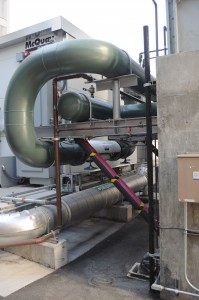 Do you own or operate a building with a small chilled water system? Are you currently part of a design team for a project that has a small chilled water system which provides chilled water in the design? If a small chilled water system isn’t designed properly it can result in uncontrollable swings in chilled water temperature and an inability to cool the building load.
Do you own or operate a building with a small chilled water system? Are you currently part of a design team for a project that has a small chilled water system which provides chilled water in the design? If a small chilled water system isn’t designed properly it can result in uncontrollable swings in chilled water temperature and an inability to cool the building load.
Small chilled water systems do have a relatively simple solution, but first, let’s take a look at what small means in terms of a chilled water system. In a nutshell, small means that the total volume of water in the entire chilled water system (including all chilled water piping, chilled water coils, the chiller, etc.) can be completely circulated all the way through the entire system in a period of time which is less than the chiller’s minimum run and off times. Chillers have minimum run and off times in order to prevent short cycling. Let’s say that you have a chilled water system designed around a chiller with minimum run and off times of three minutes each. Let’s also say that you have a chilled water pump with a design flow of 70 GPM. This means that during the chiller’s minimum run and off times of three minutes the system will circulate 210 gallons of water (70 GPM multiplied by 3 minutes equals 210 gallons). If the volume of water in the system is less than 210 gallons (or 210 gallons with a factor of safety for good measure) there may be trouble.
Let’s look at the reason why there may be trouble. Let’s say you have a chilled water system with a volume of 170 gallons, which is below the 210 gallon minimum. Let’s also say that the chilled water has a design supply temperature of 45 F and a design return water temperature of 55 F. When the chiller starts, it will run for a minimum of three minutes. But with a flow rate of 70 GPM, the entire volume of chilled water will be circulated in approximately 2.43 minutes. If this happens on a day during which cooling is required, but less cooling is required than the maximum design conditions the chiller system design was based on, we may wind up with a return water temperature which is less than the design 55 F. If this cool return water temperature enters the chiller, it could be over cooled. If the water is cooled too much, it could potentially cause the chiller’s internal cooling components to freeze up. The chiller won’t actually let this happen. Instead, it will shut itself down before freezing and potential damage occur, but this shut down often requires that a maintenance individual manually reset the machine. Most maintenance personnel don’t just sit around waiting for a chiller to shut down and require a manual reset, so it can often take several minutes for someone to show up (usually having to leave other problems they were dealing with in a part of the building far away from the chiller), diagnose the chiller shutdown, and then reset it. During the time the chiller is shut down, there is still a necessity of cooling, so the chilled water keeps circulating. Since the chiller is stuck in the off position and can’t provide 45 F water, the chilled water will begin to warm up beyond the 45 F design temperature, and cooling control will be lost. Even if the chiller is manually reset and is able to provide chilled water again, since there is less chilled water volume than is required, the same chiller shutdown can occur again and again.
The solution to all of this is to provide a storage tank in the chilled water system to provide enough chilled water volume such that the entire volume of water won’t be circulated during the chiller’s minimum run and off times. If you own or operate a building with a small chilled water system and can’t get your chilled water temperatures under control, this might be a solution to consider. If you’re currently designing a small chilled water system, it’s a simple analysis to avoid migraines after the system is built. As always, consult your local friendly chiller representative for proper chiller system design.







